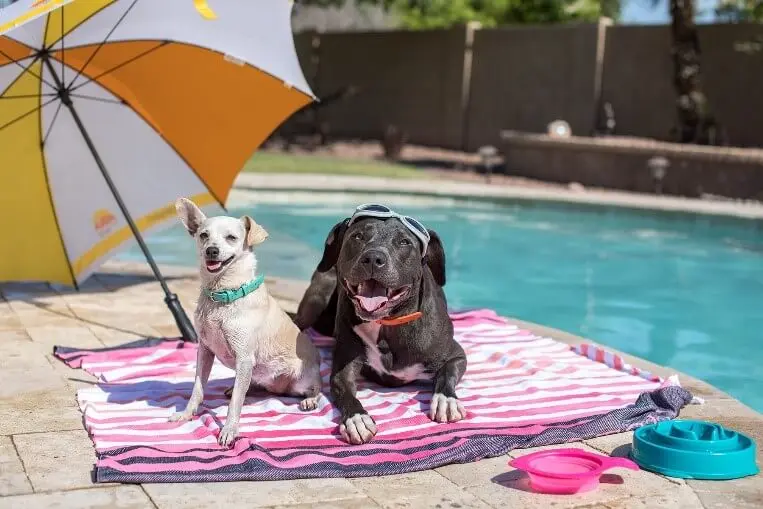While your canine companion is loving all of the fresh summer activities, it’s up to you to make sure your dog stays hydrated and cool on hot, humid days. Even lazy dogs have trouble keeping cool when the temperatures soar over 90 degrees F. Here are some tips to help you manage your dog’s comfort and health when it’s hot outside.
Your Dog Is Hotter Than You
If you routinely measured your dog’s temperature to get a baseline number, you’d notice that it averages a bit higher than your average internal temperature. Experts say your dog’s temperature should range from 100.0 degrees to 102.5 F. Even a half-degree above that is okay when a dog is exerting itself or the weather is hot and muggy.
If your dog’s temperature registers above 103 degrees, it’s time to take action. Call your vet as soon as possible to receive advice on how to proceed. The veterinarian’s office will offer you first-aid and cooling tips and will most likely request that you bring the pet to the office for a thorough exam.
Overheating (due to weather conditions) is only one cause of increased temperatures in canines. A dog with an infection may exhibit signs of a fever. If your pet eats toxic food, dangerous plants, or poisonous household items, a fever may result as well. When you’re in doubt about why your pet is too hot, let the vet’s office sort it out with professional diagnostic tools.
Support Your Breed
Supporting your favorite dog means more than being a champion for the pedigree. Certain dogs need additional consideration during the hot months to ensure their well-being and comfort.
If you have a puppy, don’t force it to exercise for extended periods. Forced exercise may lead to exhaustion or improper development. Wait until the puppy is an adult dog to exercise it for longer sessions.
Dogs with short, flattened noses and broad heads are called brachycephalic. Some of these breeds include pugs, english bulldogs, and short-haired boxers. They often become overheated due to the inefficiency of their short respiratory tracts. Limit exercising these breeds, and make certain they have plenty of shade, water, and cool areas for lounging when the weather thermometer soars.
Huskies, German Shepherds, and other dogs with long coats also need consideration in the hotter months. Limit walks to the cooler hours of morning and dusk, or walk your dog in a shady park on the grass rather than in direct sunlight on pavement or concrete. The heat and humidity are rough on thick-haired dogs, older dogs, and bigger dogs, so always bring water for your pets on even short summer walks when they meet these conditions.
Laws May Demand Proper Pet Care
Always know the laws regarding dog care where you live. In some cities, it’s illegal to leave your dog outside when the temperature goes above 90 degrees. In other cities, dogs are banned from walking trails when temperatures rise above 100 degrees. Remember to keep in mind the humidity too! If it’s only 80 degrees the weather still may be harmful to your pet if humidity levels are high.
In some towns, a stranger may legally smash in the window of your vehicle if they see your pet showing signs of heat distress on a hot day. These signs include the following:
- Rapid or excessive panting
- Glazed or bloodshot eyes
- Vomiting
- Bloody, loose stools
- Lethargy or collapse
- Seizures
- Shivering
If you see an outdoor pet suffering on a sweltering day or a pet heating up in a hot car, call the authorities as soon as possible to report the animal’s distress. Check with the police before you break any windows to rescue a pet. If the laws don’t support Good Samaritan animal rescue, you could be charged with a crime or held liable for the cost of the car damage.
Products to Help Keep Fido Cool
Researchers and inventors are developing all sorts of innovative products to help dogs survive hot weather. Tesla automobiles can now be equipped with an update called “Cabin Overheat Protection.” The large battery packs in the vehicles enable them to be kept cool for hours when monitored with the new system.
Other inventions include temperature-monitoring collars and sensors hooked up to apps on handheld devices. Pet owners can check up on their dogs at home and in the car when they step away for a moment. Cooling vests and dog shoes are also available.
Assemble Your Summer Dog Kit
First, find a proper dog thermometer. Your veterinarian is happy to suggest the best type for your breed. The two most common ways to take your dog’s temperature are rectally or in the ear. You’ll need petroleum jelly or a similar lubricant for the rectal thermometer. If you choose to do it rectally, the thermometer should normally be inserted about an inch into the rectum in order to take an accurate reading.
Also, include a portable water bowl and a few bottles of water for emergency hydration. If you have a short-haired dog you can gently dampen their coat around their head, neck, and belly during severe cases of overheating. Bring an extra water-proof sack or folding bowl for this purpose. If you think your pet is suffering a heat stroke turn the a/c on high, and drive directly to your Veterinarians office.
Contact 1st Pet Veterinary Centers today with any questions or concerns you have about your dog’s temperature. We’re here 24/7 to help you keep your dog cool when the weather’s hot.

